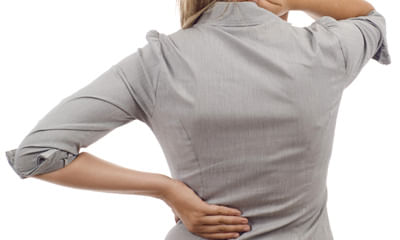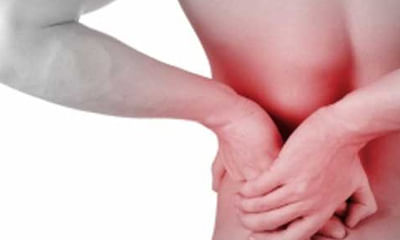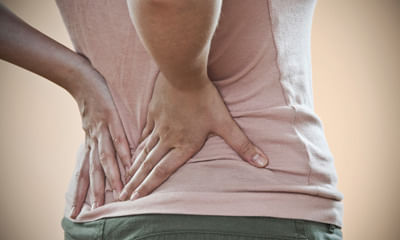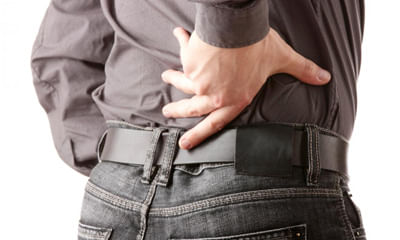Top Questions on Living with Ongoing Pain
Good morning doctors, for a long while, I do have pains (ache) all over my body but of recent, the pain is more on the r ...
Ask Free Question
Hello, miss lybrate-useras you are 49 years old and teacher by profession so this nonspecific pain will be there bcz of continuous standing and so start using calcium & vitamin d supplements or you can use women’s protein powder as supplement for eye pain you need to use just lubricants eye drop (sodium hyluronate containing) like flogel ultra or hysoft eyedrop. Druphagan I guess is antiglaucoma medication so you have undergo complete glaucoma screening otherwise if you have reports then please share .after seeing those reports I can comment wheather you have to use druophagan not.
I am having fever like feeling weakness muscle pain and knee pain infection was found in my blood report and I have had ...
Ask Free Question
I am sorry to hear about your concern but will be happy to assist you. If you test negative 3-6 months after you think you were exposed to hiv and if there is no chance you were exposed to hiv since then, you do not have hiv. Continue to protect yourself from hiv. Read more about hiv prevention. Let's connect over a call so that we can discuss your concern in details and make a treatment plan for you.
My mother age 48 my mom suffering from body pain and headache problem so long days she faced issue which tonic best heal ...
Ask Free Question
Advice assessment of vitb12 vit d3 T3T4TSH. till then A to z women one at night after dinner. calcijointd3 sachet or tab once per week for eight weeks followed by same one per month for six months. healthy diet, salad, fruits, dryfruit like best quality almonds to be soaked in night, peal.off n chew very finely at breakfast 5-11. two apricot.
My left ventricle ejection fraction is 25%.and I have 24 hour full body aches and fatigue is it due to low ef. ...
Ask Free Question
Quite possible as ejection fraction is the blood supplied by your heart to the rest of your body compared to whats in the heart.
From 4-5 year I have 24 hour full body pain and fatigue and all tests are normal. 4-5 months ago aiims doctor diagnosed ...
Ask Free Question
Also called: fibrositis self-carephysical exercise aerobic activity for 20–30 minutes 5 days a week improves cardiovascular health. If injured, pursuing an activity that avoids the injured muscle group or joint can help maintain physical function while recovering. Stress management pursuing an enjoyable activity or verbalising frustration to reduce stress and improve mental health. Relaxation techniques deep breathing, meditation, yoga, rhythmic exercise and other activities that reduce symptoms of stress hydrotherapy using water to relieve pain, treat diseases and maintain health. For example, mineral baths and hot tubs. Stretching stretching exercises can improve flexibility and improve physical function. Graded exercise therapy physical exercise that starts very slowly and gradually increases over time. Massage relaxes tense muscles. Heat therapy using heat is an excellent way to help relax muscles and encourage blood flow to areas that are particularly painful. This can easily be done at home using dry or damp hot towels. Simply hold the towel against the affected area until you feel relief. Ultrasound an ultrasound uses sound waves to produce heat which improves blood flow to deep muscle tissue. It can be used to relieve pain, stiffness, spasms, and inflammation widespread muscle pain and tenderness. Symptoms requires a medical diagnosis widespread muscle pain and tenderness are the most common symptoms. People may experience: pain areas: in the muscles, abdomen, back, or neck pain types: can be chronic, diffuse, sharp, or severe pain circumstances: can occur at night gastrointestinal: constipation, nausea, or passing excessive amounts of gas whole body: fatigue, feeling tired, or malaise muscular: muscle tenderness, delayed onset muscle soreness, or muscle spasms sensory: pins and needles, sensitivity to cold, or sensitivity to pain mood: anxiety, mood swings, or nervousness sleep: difficulty falling asleep or sleep disturbances cognitive: forgetfulness or lack of concentration hand: sensation of coldness or tingling also common: depression, flare, headache, irritability, joint stiffness, painful menstruation, or tingling feet treatment consists of self care and therapy medication, talk therapy and stress reduction may help in controlling the symptoms. Self-carephysical exercise aerobic activity for 20–30 minutes 5 days a week improves cardiovascular health. If injured, pursuing an activity that avoids the injured muscle group or joint can help maintain physical function while recovering. Stress management pursuing an enjoyable activity or verbalising frustration to reduce stress and improve mental health. Relaxation techniques deep breathing, meditation, yoga, rhythmic exercise and other activities that reduce symptoms of stress therapies support group a forum for counseling and sharing experiences among people with a similar condition or goal, such as depression or weight loss. Biofeedback controlling the body's heartbeat, brainwaves, breathing and blood pressure by monitoring them with sensors. Cognitive behavioral therapy a talk therapy focused on modifying negative thoughts, behaviours and emotional responses associated with psychological distress. Hydrotherapy using water to relieve pain, treat diseases and maintain health. For example, mineral baths and hot tubs. Chiropractic treatment techniques adjusting the spine and massaging the back muscles to relieve pain. Stretching stretching exercises can improve flexibility and improve physical function. Graded exercise therapy physical exercise that starts very slowly and gradually increases over time. Massage relaxes tense muscles. Acupuncture insertion of needles into specific points on the body to relieve pain and treat other conditions. A form of traditional chinese medicine. Medications selective serotonin reuptake inhibitor (ssri) eases symptoms of depressed mood and anxiety. Analgesic relieves pain. Nonsteroidal anti-inflammatory drug relieves pain, decreases inflammation and reduces fever. Nerve pain medication blocks pain caused by damaged nerves. Muscle relaxant reduces muscle tension and helps relieve muscle pain and discomfort. Fibromyalgia medications can help reduce the pain of fibromyalgia and improve sleep. Common choices include: •pain relievers. Over-the-counter pain relievers such as acetaminophen (tylenol, others), ibuprofen (advil, motrin ib, others) or naproxen sodium (aleve, others) may be helpful. Your doctor might suggest a prescription pain reliever such as tramadol (ultram). Narcotics are not advised, because they can lead to dependence and may even worsen the pain over time. •antidepressants. Duloxetine (cymbalta) and milnacipran (savella) may help ease the pain and fatigue associated with fibromyalgia. Your doctor may prescribe amitriptyline or the muscle relaxant cyclobenzaprine to help promote sleep. •anti-seizure drugs. Medications designed to treat epilepsy are often useful in reducing certain types of pain. Gabapentin (neurontin) is sometimes helpful in reducing fibromyalgia symptoms, while pregabalin (lyrica) was the first drug approved by the food and drug administration to treat fibromyalgia. Therapy a variety of different therapies can help reduce the effect that fibromyalgia has on your body and your life. Examples include: •physical therapy. A physical therapist can teach you exercises that will improve your strength, flexibility and stamina. Water-based exercises might be particularly helpful. •occupational therapy. An occupational therapist can help you make adjustments to your work area or the way you perform certain tasks that will cause less stress on your body.
I have weakness and pain in my body as I was diagnosed from lower back pain last few year back I am using ashwagandha fo ...
Ask Free Question
•rest. Avoid doing things that require you to bend at the hip or put a lot of pressure on the hip. Avoid sleeping on the side of your hip that is painful and sitting for long periods of time •cold and heat. Treating pain with heat and cold may help. Wrap an ice pack or a bag of frozen vegetables in a towel to ice your hip. A warm bath or shower may also help reduce your pain and prepare your muscles for stretching. •stretch. Gently stretching your body may reduce hip pain, especially if the cause is a strain or pinched nerve. 1. Knee lift 7.Lie on the back, extending both legs flat along the floor. 8.Keeping the left leg straight, pull the right knee up toward the chest. 9.Place both hands on top of the knee to help pull it in toward the chest. 10.Hold the stretch for 10 seconds. 11.Let go of the knee and gently lower the leg back toward the floor. 12.Repeat this exercise 5–10 times on each knee. 2.double hip rotation 6.Lie flat on the back. Then, bend the knees and bring them toward the body until the feet are flat on the floor. 7.Gently rotate the knees to the left, lowering them toward the floor. Rotate the head to face the right while keeping the shoulders against the floor. 8.Hold this position for 20–30 seconds. 9.Slowly return both the head and knees to the starting position. 10.Repeat on the opposite side. 3.bridging 6.Lie on the back, bending both legs at the knee and placing the feet flat on the floor. Keep the arms by the sides of the body with the palms facing downward. If necessary, place a small pillow underneath the neck and head for support. 7.Slowly lift the pelvis and lower back upward. Be sure to keep the shoulders and upper body on the floor. 8.Hold the position for 5 seconds. 9.Gradually lower the back and pelvis toward the floor, starting at the top of the spine. Roll down through the spine until the entire back is flat against the floor again. 10.Repeat this exercise 5–10 times. 4.butterfly stretch 3.Sit on the ground, bend your legs, and bring the soles of your feet together so they touch, letting your knees fall out to the sides. 4.Bring your heels as close to your body as you can and lean forward into the stretch, using your elbows to gently push your knees toward the ground. 5.side lying leg raise 3.Lay on your right side with your legs straight and stacked on top of each other, propping yourself up with your elbow. If you’re using an exercise band, position it just above your knees. 4.Keeping your hips stacked, engage your core and lift your left leg straight up as far as you can. Slowly lower back down. Repeat on other side. 6.hip flexion 7.Stand upright. 8.Extend one arm out to the side and hold on to a sturdy surface, such as a wall, table, or chair, for support. 9.Slowly raise the right knee to the level of the hip or as far as is comfortable while keeping the left leg straight. 10.Only hold this position for a second before placing the left foot back on the floor. 11.Repeat with the left knee. 12.Do 5–10 repetitions of this exercise. 7.hip extension 5.Stand upright with the legs straight and the feet shoulder-width apart. 6.Extend both arms out in front and hold on to a chair, table, or wall for support. 7.Keeping the right leg straight, lift the left leg backward without bending the knee. 8.Lift the leg as far as possible without causing discomfort, then clench the buttock tightly and hold the position for 5 seconds. Repeat this stretch 5–10 times on each leg. To increase the resistance, try attaching small weights to the legs. 8.hip abduction 5.Stand upright. 6.Extend the left arm out to the side and hold on to something solid, such as a chair, table, or wall. 7.Starting with the feet together, lift the right leg out to the right side. Keep the left leg straight and avoid rotating the hips. 8.Hold the position for 5 seconds and then slowly return the leg to the starting position. Do this exercise 5–10 times on one leg, then repeat it on the other side. Posture when standing: make sure you have a neutral pelvic position. Stand upright, head facing forward, back straight, and balance your weight evenly on both feet. Keep your legs straight and your head in line with your spine. Posture when sitting: a good seat for working should have good back support, arm rests and a swivel base. When sitting, try to keep your knees and hips level and keep your feet flat on the floor, or use a footstool. You should ideally be able to sit upright with support in the small of your back. If you are using a keyboard, make sure your elbows are at right-angles and that your forearms are horizontal. Shoes: flat shoes place less of a strain on the back. Driving: it is important to have proper support for your back. Make sure the wing mirrors are properly positioned so you do not need to twist. The pedals should be squarely in front of your feet. If you are on a long journey, have plenty of breaks. Get angle. Out of the car and walk around. Bed: you should have a mattress that keeps your spine straight, while at the same time supporting the weight of your shoulders and buttocks. Use a pillow, but not one that forces your neck into a steep.
I am an 18 year old teen girl and i've been experiencing bad body pain from last 4 to 5 days. I've this weird tingling i ...
Ask Free Question
First tell me that you take more seating time for study or other issue .have you regular periods .have you some psychotic issue .have you less blood like anemia .are you thin or hairfall or sometimes constipation .first provide me thw symptoma that I asked .may be these are present thwn due to thyroid related disorder.
Since from early morning I am having lower body pains (back, legs and thigh) n slight head ache. N then started getting ...
Ask Free Question
Normal or may be anything else. In our campus same complaints three days feel better but on third day night high fever n than rt pcr test for covid comes positive. Please consult in local place a md physician. Till then nimesulid two times a day after food or pcm 650 after food.
My mother has too much body pain specially in hands and legs. And it has formed into daily as schedule. It is happening ...
Ask Free Question
It can be due to inflammation [in-fluh-may-shun]. Swelling of the joints, muscle, or tissue can occur in the hands and feet either because of injury or because of inflammatory disorders like arthritis [ahr-thray-tis]. Nerve damage, injury, disorders. Consult us online.
I am 28 years old. I have heavy pain in my body. I can not move, walk freely. Heaviness in my had, I can not move my han ...
Ask Free Question
Kindly take rest // avoid exposure to extremes of weather // take plenty of water // take ethnic diet with plenty of fresh vegetables ;glv and fresh fruits // consult a doctor and get medicines for body pain.






